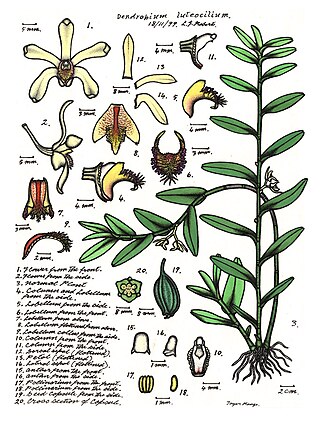
Nathaniel Wolff Wallich FRS FRSE was a surgeon and botanist of Danish origin who worked in India, initially in the Danish settlement near Calcutta and later for the Danish East India Company and the British East India Company. He was involved in the early development of the Calcutta Botanical Garden, describing many new plant species and developing a large herbarium collection which was distributed to collections in Europe. Several of the plants that he collected were named after him.

Apostasia, commonly known as grass orchids, is a genus of eight species of primitive orchids in the family Orchidaceae. They are terrestrial, evergreen, grass-like plants, barely recognisable as orchids and are distributed in humid areas of the Himalayan region, China, India, Sri Lanka, Southeast Asia, New Guinea, and Queensland. They have many narrow leaves and small yellow or white, non-resupinate, star-like flowers usually arranged on a branched flowering stem.

Amherstia nobilis is a tropical tree with large, showy flowers. It is the only member of the genus Amherstia. It is widely cultivated for ornament in the humid tropics, but is very rare in the wild and has only been collected from its native habitat a few times. It is native to Burma (Myanmar), hence the common name. The scientific name commemorates Lady Amherst, and also her daughter Sarah. Another common name, orchid tree, is also used for members of the genus Bauhinia.

Sarah Anne Drake (1803–1857) was an English botanical illustrator who worked for John Lindley and collaborated with Augusta Innes Withers, Nathaniel Wallich and others.

Dendrobium wassellii, commonly known as the furrowed pencil orchid, is a species of orchid endemic to a small area on Cape York Peninsula. It is an epiphytic or lithophytic orchid with branched stems, cylindrical, furrowed leaves and flowering stems with up to sixty crowded white flowers with a yellow labellum.
Wallichii, a specific epithet honouring Danish botanist Nathaniel Wallich, may refer to:

Zingiber barbatum is a medicinal, therapeutic ginger found in Myanmar. The plant, a rhizome geophyte, is concentrated primarily in the Yangon, Bago, and Mandalay regions, although specimens have been found in at least two other administrative regions.
Allium blandum is a species of onion native to northern India, Pakistan, Afghanistan, Tajikistan, Nepal and the Xinjiang region of western China. It grows in the mountains at elevations of 3000–5000 m.

Raphistemma was a genus of flowering plants of the family Apocynaceae, first described as a genus in 1831, It is native to China and Southeast Asia. but now synonymous and subsumed into the genus Cynanchum.
- Raphistemma hooperianum(Blume) Decne. - Guangxi, Thailand, Vietnam
- Raphistemma pulchellum(Roxb.) Wall. - Guangxi, Thailand, India, Laos, Peninsular Malaysia, Myanmar, Nepal, Sikkim

Abelmoschus crinitus is a species of flowering plant belonging to the mallow family. It was first described by Nathaniel Wallich in 1830.

Pterostylis turfosa, commonly known as the bearded bird orchid, is a species of orchid which is endemic to the south-west of Western Australia. Flowering plants have a single translucent green flower with darker green veins, on a flowering stem with up to eighteen stem leaves. It is one of a number of bearded orchids, some of which have yet to be formally described, all of which have a distinctive feather-like labellum.

Dendrobium densiflorum is a species of epiphytic or lithophytic orchid, native to Asia. It has club-shaped stems, three or four leathery leaves and densely flowered, hanging bunches of relatively large pale yellow and golden yellow flowers.
Dendrobium insigne, commonly known as the mangrove tartan orchid, is a species of epiphytic or lithophytic orchid native to New Guinea and Indonesia. It has crowded, cane-like stems with many leaves arranged in two vertical rows, and short-lived yellow and red flowers in groups of two or three.

Dendrobium pruinosum, commonly known as the honey orchid, is an epiphytic or lithophytic orchid in the family Orchidaceae and has flattened, yellowish stems and pairs of cream coloured, dull yellow or greenish flowers. It grows in tropical North Queensland and New Guinea.

Pomatocalpa macphersonii, commonly known as the blotched bladder orchid, is an epiphytic or lithophytic orchid with thick, cord-like roots, between two and eight dark green, leathery leaves and up to thirty cup-shaped, yellow flowers with red blotches and a white labellum with red blotches. It usually grows on rainforest trees and is found in New Guinea and tropical North Queensland, Australia.

Sarcanthopsis warocqueana, commonly known as the goliath orchid, is a large epiphytic or lithophytic orchid from the family Orchidaceae that forms large clumps. It has a long, thick, branched stems, thick, cord-like roots, many leathery, strap-like leaves and many cream-coloured, yellowish or greenish flowers with purple or brown spots. It grows near the sea, in coastal swamps and in rainforest, usually in full sun. It mainly only occurs in New Guinea.

Schoenorchis micrantha, commonly known as the tangled flea orchid, is a small epiphytic orchid that forms small, tangled clumps and has thin stems, many linear leaves and up to thirty small, white, bell-shaped flowers. It is found from Indochina to the south-west Pacific.

Trachoma papuanum, commonly known as the yellow spectral orchid, is an epiphytic or lithophytic clump-forming orchid with a between three and six thick, fleshy leaves and many dull yellow flowers with a white labellum opening in groups of up to four. This orchid occurs in New Guinea, Queensland and some islands in the South Pacific.
Oberonia flavescens, commonly known as the northern green fairy orchid, is a plant in the orchid family and is a clump-forming epiphyte or lithophyte. It has between four and six leaves in a fan-like arrangement on each shoot and a large number of whitish to yellowish flowers arranged in whorls of between six and eight around the flowering stem. It is endemic to Queensland.
Phreatia micrantha, commonly known as the native fan orchid, is a plant in the orchid family and is an epiphyte or lithophyte with four to ten channelled leaves in a fan-like arrangement with their bases sheathing the stem. A large number of small white, cup-shaped flowers are arranged along a thin, wiry flowering stem. This orchid is native to areas between Papuasia and the western Pacific.















